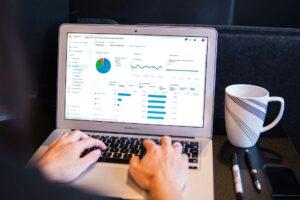What is AI Data Analysis
Data Analysis refers to evaluating data to make certain inferences. The future of AI Data Analysis refers to the integration of Artificial Intelligence into the process. While AI as a trend is booming, and more and more companies are integrating AI into their services, the need for an innovative approach to data analysis was imminent.
Due to the vast majority of data available in this day and age, standard, traditional methods are no longer feasible. It was only a matter of time before mankind came up with a solution to step up the process. This evolution is only just beginning because the future of AI data analysis is vast and filled with growth opportunities.
Table of contents
AI Data Analytic’s Current Landscape.
The market for Digital Data in 2023 accounted for a worth of $100 billion. And within this landscape, statistics highlight that 60% of businesses are incorporating AI into their data analysis approach. After all, an increase of up to 80% in efficiency was noted by those companies that integrated their data analytical processes with AI and Business Intelligence.
We live in a stage where having the right data is a synonym for having power and control. 60% of the leaders in the field are prioritizing data governance and believe in the fact that utilization of the said data is going to be the pivotal factor that leads them to success.
The Difference Between AI and Traditional Approaches to Data Analysis
Traditional Data Analysis AI Data Analysis
| Traditional analytics typically relies on predefined rules and structured data to analyze past performance and make decisions based on historical trends. Traditional analytics processes often require manual intervention and are limited in scalability due to the manual effort involved. Traditional analytics can provide insights into past performance, but it may struggle to forecast future trends accurately. Traditional analytics models are often simpler and easier to interpret since they are based on predefined rules and statistical methods. Traditional analytics models typically require manual updates and adjustments to accommodate changes in data or business conditions. Traditional analytics processes may take longer to derive insights and make decisions due to manual intervention and processing time. | AI analytics utilizes machine learning algorithms to analyze large volumes of data, often unstructured or semi-structured, to identify patterns, correlations, and insights that may not be apparent through traditional methods.AI analytics systems can automate many tasks such as data cleansing, feature selection, and model training, allowing for greater scalability and the analysis of larger datasets.AI analytics excels in predictive analytics, leveraging machine learning models to forecast future outcomes based on historical data and current trends.AI analytics models, particularly deep learning models, can be more complex and challenging to interpret, making it crucial to have methods for explaining model predictions and ensuring transparency.AI analytics models can continuously learn and adapt to new data, making them more agile and capable of handling dynamic environments.AI analytics can deliver insights and recommendations in real-time or near real-time, enabling faster decision-making and response to changing conditions. |
The Future Prospects
Artificial Intelligence: With time, integrating data analytical tools with artificial intelligence and its necessary subsets such as machine learning will be more common than ever. This means that it would be easy for small businesses to get their hands on services and tools that can deliver accurate and reliable data. True, those times may have other factors deciding upon the competition, but the use of AI and its availability shall be common to any who wishes to access it.
Augmented Analytics: This refers to the approach of making data more democratic and easily available to everyone who should have access to it. Using ML, NLP, and automation at its heart, the approach for augmented analysis delivers its solutions in a visual and insightful manner. This promotes prompt decision-making. This approach so far is not as common and usually expensive to come around, given there are few brands like Qmantic that offer these solutions.
Cloud-Based Analytics: Over the recent years, cloud services have been seen to have an increasing popularity among the masses. More and more people and services are opting for these solutions, be it to safeguard their data or simply to have an accessible storage location. In the future, more and more cloud-based services can be incorporated with data analysis. This makes accessing, sharing and integrating data into other platforms a cinch and promotes the vision of a connected world.
Conversational Analytics: Qmantic has deployed its very own custom AI assistant known as Phelina which is a conversational assistant. In the future, more of these will be common and will enable users to interact with their models and learn more about the data at hand in an efficient and easier manner. This will be done with further advancements in NLP models that will boost the level and quality of AI assistants that will be at the core of this conversational approach.
Business Intelligence: BI and AI Data analysis have almost already been coupled as the two different sides of a coin, but in the future, this will be even more so with the integration of Data Sciences. Companies are looking into their data cycles more often now and this practice has led to a totally different approach of inference new strategies at each level that can ensure growth in a complete and progressive manner.
Possible Effects of AI Data Analysis in the Future
Data Analysis started as a field or practice incorporated by companies to boost their standards and grow their business, or for researchers to compile and present their findings in a statistical manner. This field has much more to offer. From simple analysis of one’s profile to report making, presentations, growth history and so much more.
This usage of this technology and tool has no limitations. Anyone can use it at any particular niche simply to know better and improve further. The sole purpose of Data Analysis is to help people and brands move further from where they are today. It helps be the guiding beacon to chart off a course that enables innovators to make decisions that can take them to newer heights.
Be it at the individual level, team level, organizational level, business level, corporate level, national level, international level or global level, AI Data Analytics has a piece to offer to everyone at every level to help them be a better them in the coming future.
Qmantic’s Role in the Future of AI Data Analysis
We aspire to be leaders and innovators when it comes to delivering data analytical services. Much of the above-mentioned futuristic trends and innovations have already been incorporated within Qmantic’s services. We have our own native AI assistant, we offer cloud integrability, automation, and augmentation of data in customized dashboards for easy inferences and much more. Yet, we believe that our journey has only just begun.
We continuously aspire to improve and work on our services to take them up a notch. To deliver the finest standard of service available. To be the name synonymous to brand data analysis. The future of technology has many visions like that of Web 3.0. With technologies like Blockchain and Metaverse rising as trends across the globe, the way Data Analysis, and AI Data Analysis for that matter can change. Qmantic simply wishes to ensure that any such change that comes is beneficial to the process and is innovative to the future.





